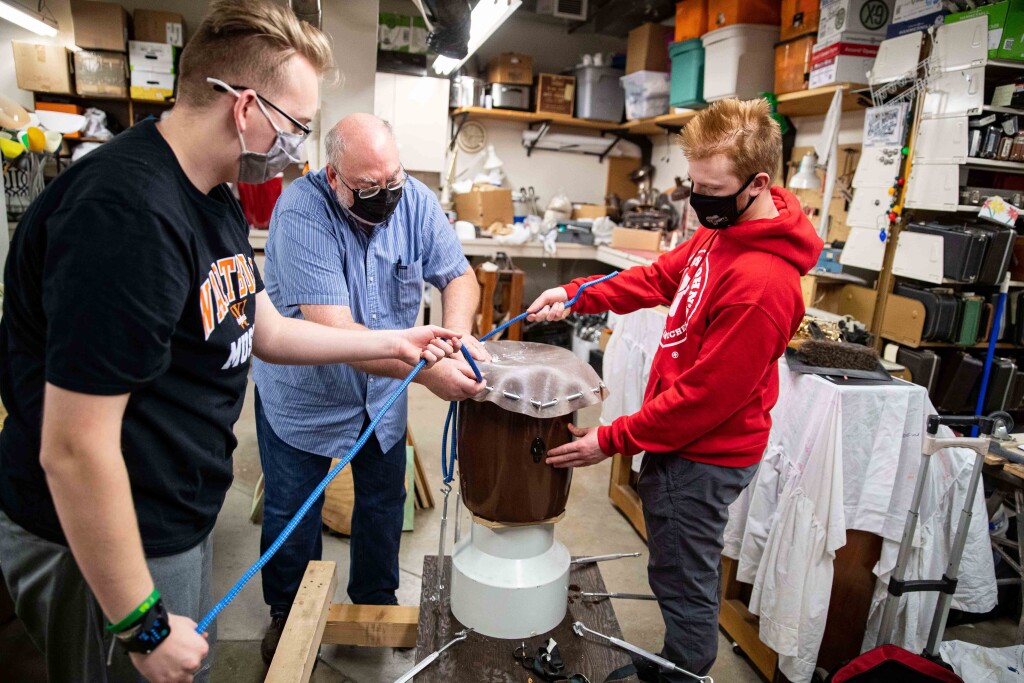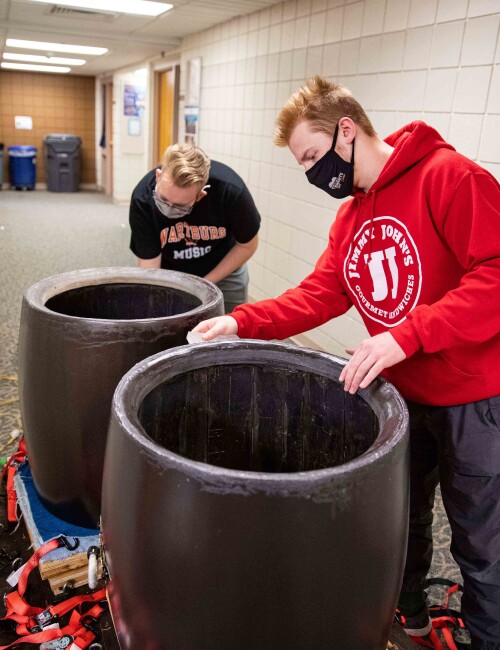Hancock makes taiko drums during sabbatical
March 3, 2021

By Stephanie Robbins Boeding ’99 | Photos Julie Pagel Drewes ’90
Dr. Craig Hancock’s shoulder injury this summer couldn’t have come at a worse time. The longtime director of bands at Wartburg College was getting ready to start a Fall Term sabbatical, a leave of absence granted to faculty for pursuits to enhance their teaching and to benefit their academic program. For his third sabbatical term at Wartburg, Hancock planned to research and practice the technique of making taiko, a form of traditional Japanese drum.
Some of the drums are quite large, and Hancock wanted to go big, using materials he found in the area. “I was mentally ready, had the whiskey barrels, had read the building manual many times,” said Hancock, and then injury set in. Surgery was needed, and Hancock continued to plan and secure materials as his shoulder healed, champing at the bit to get into his garage and start the physical work as the days went by during Fall Term. “Long before the doctor said it was OK, I was at it while my arm was in a sling,” he said.
Hancock’s fascination with taiko — a term used for a variety of traditional Japanese drums and the method of playing them — grew in 2007 with the Wartburg College Wind Ensemble’s first tour to Japan. The group, which Hancock directs, stopped in Uto in southwest Japan, which is home to a museum and manufacturer of taiko. “We took a Japanese piece to play on the tour, and had worked hard to prepare it,” said Hancock, and the group had even brought their own version of taiko-like drums along for their performances.
“As we prepped for the concert in town, someone said, ‘Do you want to use some real taiko drums?’” Hancock and the student musicians jumped at the opportunity and were taught how to play the drums and even invited to use some authentic taiko to accompany their special piece in their concert that night.
Learning about the process of making the drums in Uto and how to play them was a highlight for the group. “We toured a hangar-size place with huge tree logs to use for taiko drums,” said Hancock. “They naturally hollow out as they age, these special oak trees. They are a national protected treasure.”
Dr. Craig Hancock will host a viewing of his taiko drums and talk about the process on Thursday, March 11, from 12 to 3 p.m., in the lobby of the Bachman Fine Arts Center. All are welcome to attend.

In Iowa, finding materials to make taiko as authentically as possible was proving a tough task for Hancock, but he found an acceptable alternative to the Japanese oak: three antique whiskey barrels. “A farmer near Sumner was using them for animal feed, so they were never wet,” said Hancock. “They had some bug damage, but are usable.”
Hancock followed a manual published by a taiko manufacturing group in Maui. Some wooden nail kegs were also secured to make smaller drums and to test drum-making techniques before attempting them on the larger drums.
He’s had support closer to home, too. He and high school band director Cliff St. Clair of Spencer, Iowa, co-own three taiko drums that they can use when their bands’ repertoire calls for authentic instrumentation. “And when we aren’t using them, we loan them out, and they’ve been out all over the state,” Hancock said; the drums have been everywhere from DeWitt in eastern Iowa and all the way across to the western part of the state. “Every time I have to say the drums aren’t available, it breaks my heart a little. So I’m trying to meet demand.”
While Hancock’s goal is to learn the drum-making process and create more taiko that he can use in Wartburg’s Department of Music, he also wants to augment demand for the instruments around the Midwest and help others fall in love with taiko.
That love comes with a lot of sweat and hard work. The process of building taiko from whiskey barrels is labor-intensive, and Hancock found ways to adapt as his shoulder healed. “I never said there was something I couldn’t do; I just had to be smart,” he said.
The most interesting tool he invented for the project was a sanding machine. “Imagine a rotisserie big enough to hold a whiskey barrel,” he said. To build it, Hancock used two office chairs made of wood. Sanding the barrel produced a ½-inch layer of sawdust in his garage in Waverly. The next step was applying layers of Bondo, a polyester putty used as an automotive body filler, to the exterior of the barrel to smooth it out and to build up the rim at the top of the drum.
After dozens of hours applying Bondo, Hancock had to create and attach the drumheads. He built special platforms, using pallets that had been used to bring a heating unit into the Bachman Fine Arts Center, for stretching the rawhide heads over top of each drum. The rawhide itself was a process: finding a supplier for the size needed; soaking the thick hides to make them pliable; punching out holes to stretch and fit the heads; drying them to keep their shape; then finally attaching them to the top of the drums with decorative tacks.
With the drums now built, Hancock is ready for the fun part: playing them. “Taiko is a way of drumming,” said Hancock, who took more students to Uto to learn how to play the drums during international Wind Ensemble tours in 2013 and 2019. “Traditionally it’s a festive dance, with a specific stance and stroke when playing. You don’t just hit it; you dance and stand and stroke.”
The true test for the new taiko will be later this term, when the Wind Ensemble performs a Japanese piece that Hancock has selected for the drums’ concert debut.
